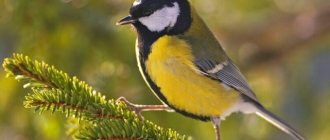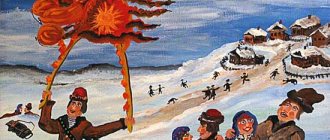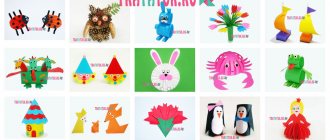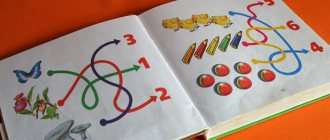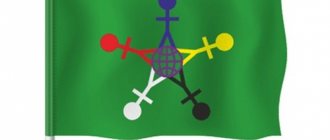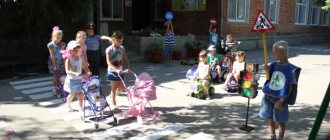The holiday that children in Rus' loved more than any other is Maslenitsa. A modern child is closer to other holidays, but you can always add one more. And if you explain to your children exactly how Maslenitsa is celebrated in Russia, then you will have the opportunity to have a great time together and at the same time get acquainted with the original Russian traditions. Most modern Russians associate the ancient holiday only with the burning of an effigy, but the celebration of Maslenitsa can be greatly diversified: with fun gifts, competitions, games, costumes and crafts.
Content:
- When does Maslenitsa start 2021 Days of Maslenitsa week
- Signs
- In kindergarten
- How to make a scarecrow for Maslenitsa
Games and fun indoors
Much more often, the Maslenitsa holiday in kindergarten is held in the music room. Various games and fun are also held here, but, of course, they are calmer than on the street.
The acoustics in the room are better, so musical games are more successful - children sing songs themselves (to the accompaniment of the music director).
Round dance games
It is good to perform various round dance games while listening to music. After all, the round dance is associated with the sun and pancakes - the main symbols of Maslenitsa. It is imperative to draw children's attention to this similarity.
The round dance symbolizes the sun and looks like a pancake - children should definitely learn about this
In the round dance game itself, you must also use holiday attributes, for example, cut out pancakes, a sun, a Maslenitsa doll, etc.
In the round dance game you need to use the symbols of the holiday
"Golden pancake"
Children form a circle. Together with the teacher and music director, they sing a song:
- Oh, damn golden! You'll go around in circles, you'll find a friend, you'll start a round dance! Masha, come out into the circle, start a dance, And we will clap, and we will trample! Oh, damn it, golden, dance with me, You are rosy, you are good, you look like the sun! Oh, damn golden! You'll go in circles.
Simultaneously with the singing, a cardboard pancake is passed around in a circle. The child who finished the song comes to the center and performs dance moves to the music. Then he bows, returns to the round dance again, and the game repeats.
"Kostroma"
A driver is appointed - “Kostroma”, he stands in the center. The rest of the guys move in a round dance, holding hands and talking with “Kostroma” to the accompaniment of music:
- “Kostroma, Kostroma, my lady! Kostromushka has jelly with pie, Kostromushka has pie with cottage cheese!” Are you healthy Kostroma? Kostroma: “Great!” Children: “Where were you, Kostoroma?” Kostroma: “On the river!” Children: “What have you seen, Kostroma?” Kostroma: “Sulfur the duck!” Children: “What are you doing now?” Kostroma: “I’m catching you now!”
After this, the children run away (the round dance “scatters”), and “Kostroma” tries to make someone look bad. The caught child becomes the driver himself.
"Round dance with a scarf"
Preschoolers should also be offered the traditional Maslenitsa round dance game using a handkerchief. Maslenitsa (an adult in the appropriate outfit) stands in the center of the circle and says the words:
- And I am Maslenitsa, I am not a stepdaughter, As soon as I go with a handkerchief, I’ll come up to you now! There is a scarf on my shoulder, whoever runs faster will take the scarf from me and call spring to us!
The children say the chant (at the same time they walk in a circle):
- Come spring, come spring! We will all have trouble sleeping! Please come soon! Feed us all with bread!
The round dance stops, Maslenitsa stands in front of the two kids and points at them with a scarf. The guys stand with their backs to each other and, according to the signal, run in a circle in opposite directions. The winner will be the one who runs faster and manages to take the handkerchief from Maslenitsa’s hands.
Of course, to play you need to use a scarf with a Russian national ornament
“Making pancakes”
You can offer the children a fascinating round dance dramatization. The host offers to bake delicious pancakes:
- To make the stove hot, you need to light a fire in it - the children represent it with loud applause.
- Now you need a frying pan. It is round, so you need to hold hands (preschoolers form a round dance). The frying pan should be heated hotter - the children dance to the sounds of a quadrille (the leader demonstrates the movements).
- Pancakes are good to eat with jam. The presenter asks what kind of jam the kids like and offers raspberry jam - the guys again take hands and run in a circle to the song “Let's go through the raspberries into the forest.”
- Pancakes can also be eaten with caviar. You need to apply it, and more of it - all the participants in the round dance are twisted into one huge ball (in a spiral, with an adult walking in front).
- The presenter reports that the pancakes turned out nice, beautiful, and rosy. Preschoolers walk in a circle to music, first in one direction, then in the other, pretending to be pancakes.
To heat up the frying pan hotter, the kids dance a mischievous square dance
After such a dance, it would be ideal to arrange a tea party with pancakes for the children at the tables.
Maslenitsa fun
Fun is not as dynamic as games. These could be improvisation tasks, creative competitions, poetry reading competitions, and riddle guessing competitions. Parents of preschool children can be actively involved in all this if they are present at the holiday.
"Skomoroshki"
For younger preschoolers, the fun “Skomoroshki” is suitable. Kids put on buffoon hats with bells and perform various tasks: they dance, show how a bear, a goose, a cockerel, a bunny, a fox walk, a goat butts, the sun rolls across the sky, etc.
Kids put on buffoon hats and perform different tasks - dance, show how a bear, a goose walks, etc.
"Cast iron"
Fun is already appropriate for older preschoolers. You will need a grip and a cast iron (just not a heavy one). The task of each participant is to carry it along the specified route (for example, a circle) without dropping it. This is not as easy as it seems at first glance.
It turns out that carrying a cast iron pot without dropping the lid is not so easy
"Goat-dereza"
This is fun for children of all ages. The teacher takes out the Goat, a Russian folk amulet doll, and asks the children what nursery rhyme they know about the goat. The guys, of course, begin to say “There comes a horned goat...”. At the end of the nursery rhyme, the adult “butts” the most serious and upset child with a goat.
The goat should cheer up the most serious child - “gore” him
"Panicle"
Children stand in a row and pass each other a broom decorated with satin ribbons, paper flowers, spikelets, etc. All this happens to a fast melody. When the music stops, the broom is in someone's hands. This child will have to guess a riddle, recite a poem or sing a ditty about Maslenitsa.
Whoever has a broom in his hands must complete a task, for example, sing a ditty about Maslenitsa
"Mail»
This is a Russian dialogue game that children must learn in advance:
- Presenter: Knock-knock! Children: Who's there? Host: Mail! Children: Where from? Host: Out of town! Children: What are they doing in the city? Presenter: clap your hands!
After the last words, the guys begin to clap their hands. Then the game starts again, only after the words “What are they doing in the city?” another task is given (they can be very different, very funny, for example, stand on one leg).
"Pancakes - flatbreads"
This is a fun and playful shouting game where there are no winners and losers. The guys are divided into two teams: one should shout “pancakes” in unison when given a signal, the other should shout “flat cakes” (children always love this). The proposed text is as follows:
- It was a good winter, we are seeing it off and joyfully welcoming the warmth of spring. We bake pancakes with seasoning (hand sign in the direction of “pancakes”)! And delicious (hand sign towards “flatbread”) flatbreads! We clap our hands cheerfully and together (everyone clap). The long-awaited oil week has arrived, and no one can count how much we ate. We ate and ate (hand sign) pancakes! And also (hand sign) flatbreads! Now let’s spin around ourselves a little (everyone is spinning). There are songs, dances, laughter, noisy festivities all around, In every house the efforts and efforts were appreciated, There are pancakes on the table (hand sign)! And next to it (hand sign) are flatbreads! To get more into us, we jump on our legs (everyone jumps). Another circle around us (everyone is spinning), And we clap our hands (everyone is clapping).
Fun related to drawing
The symbols of Maslenitsa can be played out in creative tasks related to drawing. For example, you can use the following options:
- "Sun". On each of the two sheets of whatman paper there is a sun drawn without rays. Preschoolers are divided into teams, each standing approximately 5 meters from their drawing, each given one yellow marker. At the signal, the guys run to their sheets one by one and complete the rays (each participant draws one ray). The team that finishes first will win.
- “Bake your own pancake.” Just a creative task without competition. Each preschooler is given a frying pan cut out of black cardboard, to which a yellow circle is glued - the silhouette of a pancake. The child must draw (with pencils or felt-tip pens) his own exclusive pancake. At the end of creativity, all pancakes are hung out for everyone to see.
The sun on whatman paper needs to be made unusual and funny
Pancake quiz for parents
So that parents (if they are present at the holiday) do not get bored, you should involve them in dancing, and also offer a special “pancake quiz”. For each question there are 4 possible answers:
- What holiday in Rus' was called pancake eater? (Easter, Maslenitsa , Christmas, New Year) (Other names: obezhukha, zhiroedha, obirukha, deceiver).
- What do pancakes symbolize for Maslenitsa? ( sun , moon, stars, planets).
- What kind of flour were traditional Russian pancakes made from in the old days? (wheat, rye, buckwheat, rice).
- What was the name in Rus' for pancakes in which any food was baked? (with offspring, with heat , with background, with a saying).
- What are reduced pancakes called? (donuts, pancakes , dumplings, dumplings).
- What kind of pancakes do skilled housewives bake? ( openwork , quilted, embroidered, dimensionless).
- Insert the missing word into the Russian proverb: “A pancake is not a wedge, ... it will not split” (log, glass, belly , head.), (A pancake is not a wedge, it will not split its belly).
- Who in the fairy tale by K.I. Chukovsky’s “Confusion” put out the fire with pies and pancakes? (chanterelles, whale, crocodile , bear).
- Which fairy-tale character put forward the pancake theory of the origin of lunar craters? (Carlson, Znayka , Ivan the Fool, Emelya).
- Which athletes have gloves called pancakes? ( Boxers , skiers, fencers, lugers). (These are lightweight boxing training gloves.)
- What is the name of a sports equipment with pancakes? (Spear, pole, barbell , hammer). (These are metal discs.)
- In which region of Russia was a monument to the pancake erected? ( Ulyanovsk , Tambov, Voronezh, Ivanovo).
Video: Maslenitsa holiday in kindergarten (parents are present, a lot of round dancing games)
Video: holiday at the preschool educational institution “Broad Maslenitsa” in the middle group (held in the music room, games, dances, songs and fun are demonstrated)
The bright and cheerful Maslenitsa always warms and unites both children and adults. Children from kindergarten should be instilled with the good tradition of cheerfully celebrating this holiday. A variety of games and fun can be offered to children both outdoors and indoors. The main thing is to focus on the national color and main symbols of Maslenitsa.
When does Maslenitsa 2021 start?
Maslenitsa is not celebrated on a specific day; the holiday falls on a different date each year. The date of Maslenitsa is calculated as follows: another 56 days are subtracted from the day of Orthodox Easter. In 2021, the date of Maslenitsa itself falls on March 14 , coinciding with the onset of the second week of calendar spring. Accordingly, Maslenitsa week begins earlier - March 8 , International Women's Day.
Days of Maslenitsa week
Every day of Maslenitsa is special. It only seems that unbridled fun continues all week - in fact, every day on the eve of a long fast is dedicated to its own rituals and traditions.
- First day (Monday) – Meeting. Day of the first pancake: on Monday the first pancake is baked and given to the poor or simply left on the windowsill. And on the day of the Meeting, women in Rus' taught their daughters to bake pancakes - this tradition can be observed in modern conditions.
- Second day (Tuesday) - Flirting. The day when young people looked closely at each other, choosing a suitable pair. Guys and girls decided on their future couple by going down the slides together and having common holiday dinners.
- The third day (Wednesday) - Gourmand. The very day from which the popular expression “to the mother-in-law for pancakes” came from. On Wednesday, sons-in-law went to treat their mother-in-law, and it was believed that the richer the mother-in-law set the table, the better she treated her daughter’s husband.
- Fourth day (Thursday) - Revelry. A day that fully lives up to its name - on Razgul in Rus', both adults and children had fun: they rode in sleds, danced in circles, played snowballs and captured snowy towns.
- Fifth day (Friday) - Mother-in-law's evening. Mothers-in-law paid a return visit to their sons-in-law; the host's duty was to treat the mother-in-law and other guests whom she wished to invite. The tradition has served and can continue to serve to strengthen the relationship between the two families.
- Sixth day (Saturday) - Sister-in-law's gatherings. The husband's sisters came to visit their daughter-in-law, who was supposed to bake pancakes for the girls. It was considered indecent to come empty-handed on this day - sisters-in-law gave their brother’s family a good gift.
- Seventh day (Sunday) - Farewell. On the last day of Maslenitsa, it is customary to ask for forgiveness from loved ones and remember the departed. But the festivities still continue: with round dances, dancing and sledding. The last symbol of farewell to Maslenitsa - the burning of an effigy - occurs on the seventh day of Maslenitsa week.
What should you tell children about Maslenitsa?
In order for children to be interested and understand the idea of the holiday in which the family is going to participate, it is necessary to tell in an accessible form about its content. You can read books to preschoolers, look at pictures on the Internet. And yet, an emotional, accessible story from an adult will help the child better feel the upcoming event. In this case, what can parents tell their children about Maslenitsa?
Maslenitsa is a holiday symbolizing farewell to a boring winter and a welcome to the long-awaited spring. The tradition of Maslenitsa days has always been wild fun and manifestation of generosity, as our ancestors considered this to be the key to rich harvests and abundance in the coming year. The holiday lasted for seven days, each day was named and celebrated in a special way. The main treat all week is pancakes, symbolizing the spring sun. A cheerful decoration for the event was the construction of a straw doll or stuffed animal, named after the Maslenitsa holiday. The scarecrow was placed on the main square where the festivities took place (you can give a preschooler a small straw doll). Calling on the sun, they tried to please Maslenitsa, shouting out calls:
Maslenitsa, Maslenitsa, Come visit us in the wide courtyard. Ride in the mountains, roll around in pancakes, amuse your hearts!
Traditional for the holiday was participation in folk entertainment, competitions, and round dances. People sang, joked, and made fun of Maslenitsa. On the last Maslenitsa day, a straw doll was burned, rejoicing in the upcoming spring days. Simple but exciting entertainment: sledding, taking snow forts - attracted both children and adults.
The history of the holiday in Rus' and the traditions of Maslenitsa
Our ancestors, the ancient Slavs, came up with the idea of celebrating Maslenitsa. Then, as now, the holiday was a symbol of farewell to winter. But Maslenitsa was celebrated in Rus' not at different times, but always at the same time - on the day of the spring equinox, after which the day becomes longer than the night. The ancient Slavs said goodbye to winter and welcomed the beginning of spring, trying in every possible way to appease the sun that rarely peeked out. Therefore, the history of the holiday is closely connected with various round shapes that reminded people of the sun: the ancient Slavs baked round pancakes and launched wooden burning wheels from the mountains.
The traditions of Maslenitsa are easy and pleasant to observe: in Rus', during the days of Maslenitsa week, it was customary to go on a visit, ride a sleigh, build ice and snow fortresses, and organize street competitions. On the last day of the holiday, a straw effigy was necessarily burned - this ritual was considered the main sign of the passing of winter.
Signs
The main sign of Maslenitsa is, of course, associated with pancakes. Each family baked as many pancakes as possible, and it was believed that if the pancakes turned out smooth and beautiful, then the family would have a successful year. Failed, burnt pancakes indicated that the year would be difficult.
It was considered a good omen to arrange matchmaking during Maslenitsa week, and ideally, to have time to have a wedding before Maslenitsa was over. The Russian people have noticed that couples who unite during the period of farewell to winter live in love and harmony.
Other folk signs for Maslenitsa:
- throwing everything unnecessary out of the house means letting in something new;
- you cannot quarrel, swear and do bad things;
- It’s a bad omen to skimp and not treat your loved ones and friends to Maslenitsa.
Signs related to weather:
- frosts on Maslenitsa - for a hot summer;
- rains - an abundance of mushrooms;
- a lot of snow during Maslenitsa week means early spring.
Christian rituals
Despite the fact that in Orthodoxy Maslenitsa is tied to Easter, the ancient holiday is not mentioned in the church calendar. The tradition of celebrating farewell to winter continued even after the adoption of Christianity in Rus', but the holiday itself has changed a little. Now Maslenitsa week precedes Lent, and at this time believers no longer eat meat - only dairy products are allowed.
Christians have preserved the ritual of burning effigy on the last day of Maslenitsa week. On this same day - Forgiveness Sunday - all Orthodox people ask each other for forgiveness for all possible insults and insults.
How they celebrated then and how they celebrate now
The traditions accompanying each day of Maslenitsa week have not survived to this day. In Rus', they strictly observed the customs of visiting mothers-in-law, sons-in-law, daughters-in-law, and choosing a beloved on a certain day of Maslenitsa. Now, of all the traditions of seeing off winter, only folk festivities have been preserved.
Modern Maslenitsa is celebrated in cities and villages: in parks, squares and on main streets. Adults and children dress up in costumes of parsleys and buffoons and participate in theatrical performances and competitions. Until now, as in former times, they organize funny folk games: tug-of-war, play snowballs, throw felt boots into the distance and, of course, burn a scarecrow.
What do they give for Maslenitsa?
Maslenitsa has always been and remains a family holiday, and gifts can only be given to the closest people. Traditional gifts for Maslenitsa, which were customary to give in Rus':
- tableware: sets of wooden utensils, butter dishes, jars for honey, caviar dishes;
- sweet treats: lollipops, buns, gingerbreads, rolls;
- decorations: scarves, ribbons, hairpins, shawls;
- costumes corresponding to the theme of the holiday;
- handmade crafts.
You can also choose a more modern gift option: ceramic dishes, refrigerator magnets, pancake makers, baking dishes, crystal, themed souvenirs.
Maslenitsa games for children of all ages
Fun is fun, but we must not forget about the age of the participants. So, many entertainments will be beyond the capabilities of children. Therefore, when developing the Maslenitsa scenario, you need to take this point into account: if children of different ages will be present at the holiday, you need to come up with separate entertainment for each age group.
Entertainment for kids
For kids, you can arrange a whole quest entertainment based on “pancakes”. Its scenario is described in the table.
| Presenter's speech | Actions of participants |
| Offers to bake pancakes, and to do this, light the stove and make a fire in it | Stand in a circle, clap their hands, stomp their feet |
| Now let's knead the dough | Bend over and reach down with your arms, making rhythmic bends |
| We need a frying pan | Children pretend to be a frying pan by holding hands and forming a round dance. They begin to dance to the fiery music |
| Next, the host says that it is better to eat pancakes with jam and asks which jam is better. Then he offers raspberry jam, playing a tune about a raspberry | The kids begin to dance in circles |
| You can still eat pancakes with caviar, placing it in a heap | The guys, led by the leader, form a spiral and, while dancing in a circle, twist into a ball |
| Oh, what golden brown pancakes we got! | To the music, kids walk first in one direction, then in the other, pretending to be pancakes. |
The following activities are also suitable for kids:
- Skomoroshki
Put buffoon hats with bells on the children and give them various tasks. Let them dance, depict how bears, cockerels, bunnies, foxes walk, how a goat butts, how the sun rolls across the sky, etc.
- Snowdrops
You need to prepare snowdrop flowers from paper in advance and scatter them on the snow. Let the kids collect flowers to the sound of cheerful music; whoever collects the most wins.
- sweet tree
You need to find a short tree or bush and hang various sweets on its branches. Task: jump up and take the gift. You can stretch a rope and hang a gingerbread, an apple or other goodies on it, inviting the children without hands or with their eyes closed to bite off the gift.
Games for preschool children
For preschoolers, the above entertainment can be diluted with the following fun:
- Jump rope
Two adults take the rope and pull it like a skipping rope, the children must jump over it. You can jump one at a time, counting the number of jumps, or do it all together, playing for elimination.
- Kings of the hill
For fun, you will need a large mountain, which one participant climbs, calling himself the king of the mountain. The rest must climb the mountain, try to overthrow the king and take the throne themselves. The task of adults is to make sure that the guys do not push too roughly.
- A cap
Fun for boys who, on command, must knock each other's hats off their heads. They play in pairs.
Interesting fun for schoolchildren
To prevent older brothers and sisters from getting bored, you can involve them in the fun too. Boys can especially distinguish themselves and show their prowess and strength if they can be offered:
- Fist fights
You can fight as a couple or as a team – wall to wall. You can push, hit with pillows or balloons. You cannot grab clothes, tear them, or fight with your fists. The fun will be more interesting if the players stand on some hill.
- We cut firewood
You can ask high school students to cut a thick log with a regular saw.
- Climb the pole
A well-known fun for Maslenitsa, for which you need a long pole driven into the ground. The boys' task is to climb the pole as high as possible and get the prize. To complicate the task, the pole can be doused with water.
- Russian beauty
While the boys show off their strength, the girls can boast of their beauty and figure. To do this, they are given a folk costume, in which they need to walk around, showing their grace. Afterwards, the participants are given rockers with water. The challenge is to walk with a heavy load without losing grace.
- Stilts
All students can test their ability to maintain balance. To do this, they are asked to stand on stilts and walk a few meters. The task should be gradually made more difficult by asking participants to step on drawn circles with stilts.
- Cockerels
An interesting task - cockerels.
A circle is drawn on a flat area, into which two players are invited. The couple enters the circle and, jumping on one leg and holding the other with their hand, tries to push the opponent out of it. You can only push with your shoulders. The participant who is pushed out is eliminated. The winner competes with the winner from the next pair.
Team fun for kids of all ages
Competitions among schoolchildren can smoothly flow into team competitions in which children of all ages can participate. Fun starts can consist of the following tasks:
- Pancake relay
For the competition you will need pancakes and frying pans. Task: run with a frying pan with a pancake, tossing it at least three times.
- Tug of War
A well-known Russian game in which each team tries to win the other over to its side.
- Snow labyrinth
You need to prepare a snow labyrinth with a confusing route in advance. It is necessary to go through the maze for a while for the whole team in turn. The group that completes the task faster wins.
- Peacock tail
A rope or broom is tied around the waist of the first team member so that its end hangs to the ground. A snake is formed from skittles or plastic bottles. Task: go the distance without hitting a single object with your tail. The passage is repeated by the rest of the team members. It is better to make two snakes at once so that the teams can cover the distance at the same time.
- Fire victims
Two circles are drawn for each team. The first one contains various household items, clothes, etc. The task of the team members, blindfolded, is to move all the things to the second circle. They act according to the prompts of their team “hot”, “cold”, and the task is complicated by the preliminary promotion of the “fire victims”.
- Fun trip
For the competition you will need ice cubes or cheesecakes. One driver is also selected, who must take turns using this vehicle to transport the entire team to the other side.
- Tripod
Team members are divided into pairs. In a pair, the right leg of one participant and the left leg of the other are tied. Thus, you need to run a distance with obstacles and pass the baton to another pair.
- Bags
A whole bunch of snowballs are piled up in front of each team at the start. The group's task is to move the snowballs to the other side. The difficulty is that you need to grab snowballs not with your hands, but with two sticks.
- panicles
The teams stand in a row. The first participant is given a broom. Task: while playing music, pass the broom to your neighbor and run to the end of the line. The group whose first person becomes first again while holding the broom wins.
- Slide downhill
If there is a slide nearby, you can arrange a competition on it. To do this, each team member is given a glass of water. Task: ride down a slide without spilling a drop of water. You can also set a goal to drive as far as possible, throw a snowball at the target at the finish line, shout a patter on the descent, or guess a riddle. There can be many options for exciting fun.
How to celebrate Maslenitsa with your children
You can celebrate Maslenitsa with your child so that he will forever remember what the holiday is dedicated to and the customs associated with it. Before you go to the mass celebrations, tell your children about the history of Maslenitsa - the story can be supplemented with Russian folk poems and songs dedicated to Maslenitsa.
Speaking of festivities, check to see if your city hosts children’s programs dedicated to seeing off winter. If there are no events for children, perhaps you should refuse to attend a general holiday, where drunk people will probably be present.
To avoid losing your child in the crowd at mass celebrations in honor of Maslenitsa, install the “Where are my children” application. With it you can accurately track the child’s location and route, quickly contact if necessary and listen to what is happening around!
You can have a fun Maslenitsa with your child without attending a city festival: bake pancakes together, make a scarecrow figurine, play on the street and invite guests to Maslenitsa pancakes.
In kindergarten
You can introduce children to beautiful Russian rituals from a very early age - even kids will remember this interesting holiday, and Maslenitsa will not become for them just a day when they are supposed to eat pancakes.
Every day of Maslenitsa week in kindergarten can be made special by telling in an accessible way about the history and traditions of Maslenitsa. An approximate holiday plan is in the table below:
| Monday (Meeting) | Tuesday (Flirting) | Wednesday (Gourmet) | Thursday (Razgulyay) | Friday (Broad Maslenitsa) |
| Making dolls with your own hands from straw, twigs, shreds. | Making crafts in the shape of the sun, round dances. | Drawing pancakes and an exhibition of the resulting drawings. | Outdoor games, introduction to carols. | Songs, dances, round dances, pancakes. |
At school
Maslenitsa is an emotional holiday, in which there is a competitive spirit, and schoolchildren are willingly involved in organizing the farewell to winter.
With small children - primary and secondary students - it is better to celebrate the holiday within the walls of the school. How to celebrate Maslenitsa in the classroom:
- prepare the room: make room, decorate the classroom with balloons, crafts in the shape of pancakes and the sun;
- show invited parents a performance - theatrical or puppet - according to a pre-rehearsed script;
- arrange a tea party and entertainment with dancing, games and competitions.
After the holiday is over, you can play in the school yard and go down the slides.
It will be more interesting for high school students to celebrate outside of school: parents can organize a trip for adult children to a cafe that serves pancakes. After hanging out together, the guys will probably linger longer - they’ll want to go down the slides or just take a walk. Make sure your child's phone or smartwatch is charged in advance - and don't worry unnecessarily.
Haven't gotten yourself a smartwatch with GPS yet? Order them right now and have peace of mind for your child throughout the holidays - know where he is and what is happening around him! Official smartwatch store.
Maslenitsa game ideas for children
As you bid farewell to the winter, you can teach your children to play ancient, almost forgotten games. For example, in these:
- “Burners”: children stand in a “stream”, the driver’s task is to catch one of the first pair running away, the one who did not get a pair continues to drive;
- “Sun”: the driver in the center depicts the sun, the rest of the children dance around it, narrowing and expanding the circle, on the fourth round the driver says “I’m burning!” and tries to catch one of the players;
- “King of the Hill” is perhaps the most fun winter game in the fresh air: one child climbs onto a snow mound and announces that he is the king of the mountain, the task of the other children is to pull the “king” off the mountain and take his place.
Ideas for Maslenitsa competitions for children
On Maslenitsa you can play fun outdoor games with your children in the classroom or on the street:
- tug of war is the most popular Maslenitsa pastime: the guys are divided into two teams, a line is drawn in the middle between them, and the task of each team is to pull the rope towards themselves. The team whose member crossed the line loses;
- “Bathhouse” - for the game you will need small brooms, which you can make yourself during technology lessons from branches and colored paper: the task of each team is to beat colored paper decorations from their brooms onto the backs of their opponents;
- “On three legs”: children are divided into pairs, the right leg of one of the pair and the left leg of the second are tied, and in this way the participants get to the established line and return. The fastest pair wins;
- “Jump rope” - for the competition you will need two adult participants: adults twist the rope, children take turns jumping over it. The one who has jumped the most times wins;
- “Balloon fight” is a safe analogue of fist fights: children from two teams are given balloons on long handles, and they fight with these “swords” until all the balloons of one of the teams burst.
Maslenitsa outdoor games
The ancient Slavs believed that if you spend the entire Maslenitsa week boringly, then there will be no luck next year. And having had a lot of fun during the holidays, you can already do a good job. That is why in Rus' there were so many games and fun dedicated to Maslenitsa. It is imperative to tell preschoolers about this and invite them to organize a holiday on the eve of spring. This can be done on the street. At the same time, the predominant entertainment will be outdoor games so that the children do not freeze.
You can invite your parents to such an outdoor celebration. It’s good to ask them in advance to prepare some holiday attributes for the children: for example, for girls - scarves in the Russian folk style, for boys - masks or unusual hats. It will be great if the teacher dresses up in an appropriate costume that matches the color of the holiday, for example, transforms into Spring (a green sundress over outerwear, a wreath with flowers and ribbons).
If the teacher puts on a costume that matches the color of the holiday, the children will be delighted
"Carousel"
Traditionally, the carousel game was played during Maslenitsa festivities. To do this, a high pole was installed in the square, to which long multi-colored ribbons were attached. The kids grabbed them and ran around.
This kind of fun can be arranged in the kindergarten area. The short pole can be held and rotated by an adult. You can also use a hoop (ribbons are tied to it); again, the teacher stands in the center and rotates it.
When the children start running, the adult turns the pole in the right direction.
The rules of the game can be very different depending on the age of the children. For kids, it will be enough to move at different paces according to the words of the famous song (pronounced by an adult):
- Barely, barely, barely The carousel spun, And then, then, then, All running, running, running. Hush, hush, don't rush, Stop the carousel, One-two, one-two, The game is over.
For older children, the rules can be complicated. Preschoolers run in a circle to the tune of a Russian plus melody (you can take speakers outside) or to the beat of a tambourine. When the music stops, each child must grab the end of the ribbon (before that they do not touch them). At the same time, there is one less ribbon than there are children: the child left without a ribbon is eliminated. Then the game continues until there are two participants and one ribbon left (each time one is untied from the pole or hoop).
Video: "Carousel" game in kindergarten"
This game can be played with kids both indoors and outdoors. In the latter case, the accompaniment can be a tambourine, and the song is sung by children and adults in chorus.
"Burners"
You should definitely offer the kids traditional Maslenitsa burners. At the beginning of the game, children form a “stream” - they stand in pairs in a column, take hold of the handles and lift them.
Maslenitsa burners will amuse the children, like their peers many centuries ago
The couple standing at the very end runs forward in a “corridor” under clasped arms. When all the pairs have run in this manner, the children sing in chorus the song “Burn, Burn Clear!”:
- Burn, burn clearly, so as not to go out! Look at the sky, Birds are flying, Bells are ringing: - Ding-dong, ding-dong, Run out quickly!
After this, the couple standing in front scatters to the sides, and the driver (let it be an adult for the first time) tries to catch one of these guys. If the children managed to run to the end of the column and hold hands again, then the next pair will run away. If one of the participants is caught, then he becomes the driver (the previous one takes his place).
The game “Burners” is more suitable for older preschoolers, as it requires a certain dexterity and speed.
"Trap"
On Maslenitsa, you can also play games familiar to children, but they must be given a festive flavor. For example, in the game “Trap” the driver is dressed up as a goat.
You can add a Maslenitsa flavor to familiar games, for example, by dressing the driver as a goat
The goat (or goat) is a traditional Slavic mummering character. The costume of this animal (a wooden head with horns, a beard made of straw, a casing turned outward with wool) was worn during Christmas and Shrovetide rounds. This animal was considered a symbol of fertility and a rich harvest. Sometimes they even brought a live goat to Maslenitsa.
Participants turn to the “goat”:
- Little gray goat, little white tail, We'll give you something to drink, We'll feed you, Don't butt us, But play Trap.
After the last words, the players scatter around the court, and the “goat” tries to catch up with someone.
Maslenitsa fights
What would Maslenitsa be without fist fights? Only in kindergarten this game needs to be made safer: participants do not fight with fists, but use balloons in the shape of sticks (you can even make swords). Participants stand on a bench and strike each other, trying to knock down the opponent.
Traditional fist fights should be made safer
Competition "Snowdrops"
Since Maslenitsa is also a meeting of spring, you can use the symbol of this time of year, for example, a snowdrop, in the game. You will need quite a lot of artificial flowers (they can be made in advance with the children during the lesson), or again they can be made from long balloons. Preschoolers are divided into two or three teams. Music plays while an adult scatters snowdrops in the snow. As soon as the melody stops, the teams begin to collect flowers. The winner is the owner of the largest bouquet.
Preparing for the holiday is also a holiday, so older preschoolers will be happy to make snowdrops with their own hands
"Masha the Confused"
Children form a long “chain” - holding each other by the shoulders or waist. The driver stands first and starts running around the area in different directions. The players’ task is not to break the “chain” and not fall (the most difficult thing is for the children standing at the end). When someone falls, they are out of the game.
Video: fragments of the Maslenitsa holiday in a kindergarten on the street
DIY costume for Maslenitsa
Spectacular and easy-to-make costumes for Maslenitsa - buffoon for boys and Spring for girls.
How to make a buffoon costume with your own hands:
- A colorful women's robe that fits in size is cut off from the bottom and hemmed - it turns out to be a future shirt for the buffoon.
- Slits are made on the sleeves of the shirt so that the sleeves hang down a little.
- The lower part of the costume is made from pants that are too big for the child, sewing in an elastic band at the waist.
Creating a headdress for a costume is also quite simple; watch the master class on making a hat for a buffoon with your own hands here:
How to make a Spring costume for a girl:
- Choose a flared dress in a suitable color - preferably green.
- Glue or sew paper or fabric flowers onto the dress.
- Place beads on the girl’s neck and a wreath on her head.
A beautiful wreath of artificial flowers can be made like this:
If you have no free time at all, but want to make a costume with your own hands, choose one of the simplest options:
- Spring look for a girl: over any spacious flared sundress, wear a tight, fitted sleeveless vest;
- bear costume for a boy: put a fur coat on your child turned inside out and complete the look with a bear mask;
- goat costume: attach beads and bells to the fur coat, make horns from cardboard.
You can create an image suitable for Maslenitsa even simpler: put on a boy any mask or false beard, and add themed accessories to the girl’s regular clothes, for example, a bright scarf, a sash, or beads made from bagels.
Crafts for Maslenitsa
The most popular craft for Maslenitsa is, of course, a stuffed animal. It may be difficult for small children to make a stuffed animal - with kids it is better to make a talisman doll or a sun.
How to make a scarecrow for Maslenitsa - step-by-step instructions
Nail two wooden sticks (one longer, the other shorter) to each other to form a cross - this will be the basis for the scarecrow.
- Tie the resulting figure with straw.
- Make the head from crumpled newspapers, cotton wool or dry grass, wrap the resulting round shape with a bright scarf or a suitable piece of fabric.
- Make a face for the scarecrow: mark the eyes with buttons, the mouth, nose and cheeks with red lipstick.
- Tie the finished head tightly to the craft figure.
- Dress the stuffed animal in old clothes.
A slightly more complex option for creating a scarecrow:
How to make a talisman doll - step-by-step instructions
Take a piece of fabric measuring 20 by 20 cm, place a small piece of tightly rolled cotton wool in the center of the fabric;
- Fold the fabric evenly diagonally.
- Using a long thread of the same color as the fabric, form the doll’s head: wrap a piece of cotton wool several times and secure with a knot (the main function of the doll is to protect the owner, so make the number of wraps even), do not cut the thread.
- Using your hand, form the waist and wings of the craft, bring the thread to the front of the doll, wrap the waist crosswise several times, and secure with a knot.
- You can use a thread of a different color to make a halo for the doll.
Another option for making a talisman doll:
How to make sunshine with your baby on Maslenitsa - step-by-step instructions
- Draw an even circle on a piece of thick white cardboard.
- Make the sun's face: draw with pencils, finger paints, or use Easter products - stickers, safe dyes.
- Cover empty spaces on the sheet with glue.
- Immediately add millet before the glue dries.
- Wait for the glue to dry and shake off any excess millet.
You can also make the sun like this:
Become your child's best playmate: play together in the yard, take part in competitions, bake pancakes for the whole family. Do not doubt - your children will remember the unusual holiday, and in the future they will preserve the tradition of celebrating Maslenitsa in their families.
2
